Guide to U.S. Jefferson Nickels
The Jefferson Nickel has been the longest running series for the five cent denomination. Featuring a portrait of Thomas Jefferson, the 3rd President of the United States, the design was introduced in 1938. This came after the introduction of the Lincoln Cent and Washington Quarter and represented the third series of American coinage to feature a former President on the obverse. During its long history, the Jefferson Nickel has undergone a temporary composition change and in more recent years, a number of obverse and reverse design changes.

Design
The original Jefferson Nickel was designed by Felix O. Schlag. A left-facing portrait of the former President is shown on the obverse with required inscriptions “IN GOD WE TRUST,” “LIBERTY,” and the date. The reverse features an image of Jefferson’s historic home known as Monticello, with inscriptions “E PLURIBUS UNUM,” “UNITED STATES OF AMERICA,” “MONTICELLO,” and “FIVE CENTS.”
This same design remained in use without any significant changes for more than six decades. Then, a series of rotating designs was issued from 2004 to 2006 to commemorate the bicentennial of the Louisiana Purchase and Lewis and Clark’s expedition. Over the course of three years, the Westward Journey Nickels would feature four different reverse designs before reverting to the original image of Monticello. The obverse would feature two new portraits of Jefferson, with the second serving as the replacement going forward.
Collectibility
Despite its lengthy duration, the series remains approachable for beginning collectors. It is possible to find the earlier dates of the series in circulation, and even an uncirculated set does not include any expensive key date coins. Advanced collectors can also find challenges in assembling a set of gem condition coins with well-defined strikes, as represented by the appearance of “Full Steps” on reverse.

